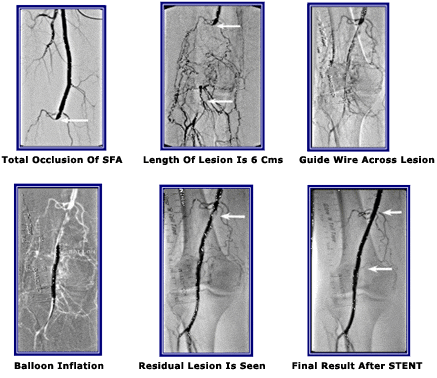Femoral Artery Angioplasty – Case Study

Case 01 : Short Discrete Stenosis of the Femoral Artery
A 30-year-old tobacco chewer presented with pain in the lower thigh and calf on walking for a short distance. Examination revealed a very feeble popliteal pulse. Angiography revealed a severe 90% short stenosis in the femoral artery which was adequately relieved with balloon angioplasty. The patient’s symptoms were relieved immediately.
Case 02 : Chronic Total Occlusion Of The Superficial Femoral Artery
The peripheral arterial occlusive disease most commonly involves the Femoro-popliteal arteries. Whilst stenosis usually tends to be short, occlusions may involve long segments of the artery, sometimes the entire arterial length. Balloon angioplasty and stenting techniques have almost done away with the need to perform graft surgery in such cases. Even chronic long segment occlusions can be treated. This case demonstrates the good results seen even in chronically occluded arteries.


Case 03 : Stenting For Short Segment Femoral Artery Occlusion

Case 04 : Thrombolytic for Acute Distal Femoral Artery Occlusion
The above case demonstrates use of clot dissolving drugs in cases of sudden occlusion of the femoral artery in the thigh. In this particular case, the femoral artery was occluded suddenly due to a clot which originated from the heart. A catheter tube was placed into the femoral artery, and streptokinase (a clot dissolving agent) was injected directly into the clot for a few hours. The second picture shows partial flow of blood after a few hours, and completes removal of the blockage by 24 hours. This type of treatment (catheter directed thrombolysis) can help to prevent gangrene and save the amputation of the leg.
Case 05 : Sudden Total Occlusion of Origin Of Femoral Artery
45-year-old male, the chronic smoker, presented with sudden pain in the left leg. Examination revealed a cold, pulseless left leg, with blue toes. The femoral artery was palpable, but the popliteal and foot pulsations were absent. Immediate angiography was performed to prevent possible gangrene. This revealed a fully occluded femoral artery. This was opened with balloon angioplasty followed by stenting. There was immediate on table restoration of distal blood flow, with the relief of symptoms within a few hours. The patient recovered fully.

